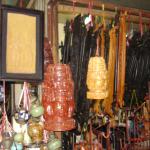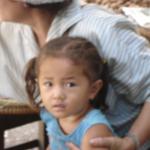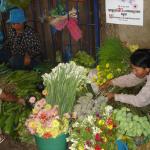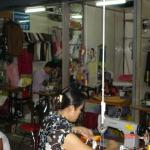Marketing Phnom Penh (Part 1)
Part 1. The Russian Market (Phsar Toul Tom Poung)
As we walked through the glass door held by a bowing uniformed boy, we left the air conditioned comfort of Raffles Le Royal and were instantly hammered by the real world of oppressive heat and humidity. It was 9 AM and the streets were a sauna. Our exit from the hotel created an immediate hubbub among the throng of moto, taxi, cyclo and tuk tuk drivers who hang out across from the front gate of the hotel awaiting potential clients.
Today's explorations involved visits to Phnom Penh's three major phsars--traditional markets: Phsar Toul Tom Poung, referred to by all as the Russian Market, Phsar Thmei, known popularly as the Central Market even though the translation means New Market, and Phsar Chas, the Old Market, which is geared to locals and seldom visited by tourists.
Our plan was communicated to the driver of the Cambodian variation of a tuk tuk--a motorcycle that is rigged to pull a two wheeled canopied carriage with two comfortably padded benches facing each other. We spent a few minutes playing the requisite negotiation game; he delivered his price with a stern face and we reacted with feigned outrage. Suggesting a price that was half the first, he beamed a smile, and our agreement was made. He would wait for us at each market and then take us to the next. Our outing would be about six hours long, including a lunch stop at the Foreign Correspondents' Club. We would soon discover there were factors we had forgotten to calculate into our neat itinerary equation.
Traffic was heavy and the roads were a confusion of vehicles all intent on making progress as swiftly as possible. Imagine the bumper cars at a carnival midway, but miraculously without the banging and ramming. As a consequence of an absence of traffic lights, many intersections are a chaotic jam. From all four directions cars, buses, bicycles, tuk tuks, motos, cyclos, along with a dozen or so vendors carrying shoulder baskets, magically wedge their way forward through the congestion. Everyone uses the same method-see an opening and seize it. All passengers can do is trust in the driver's experience, hold on tightly, try not to breathe the exhaust fumes and pray that the jerky horn honking madness will soon end.
After ten minutes of white knuckle road adventure, we arrived at the sprawling Russian Market, adrenaline charged, eyes stinging, throats burning, and hearts thumping.
The driver had a fierce grin on his face and his eyes were blinking uncontrollably, indicating that not only his passengers had been affected by the perilous journey. In an attempt to give the illusion of composure, we asked the driver why this was called the Russian market. His reply in a still shaky voice was "Yes, yes, Russian market."
As we walked through one of the entrances of the immense bazaar, we were instantly approached by a tout soliciting clients for his taxi service. When asked the same question about the name of the market, he barked, "Yes, yes. Russian Market. Russian Market. You want taxi?"
Abandoning further attempts at journalistic research, we surrendered to the vast dimly lit maze of bustling aisles realizing immediately that getting lost was inevitable.
Textile vendors, tucked into their stalls surrounded by goods that appear to have tumbled around them in an avalanche, poked their heads out and entreated passersby to stop, to look, to buy; their coworkers manned the narrow corridors displaying pants and scarves, tablecloths and bras, sarongs and shirts, house coats and children's clothes praising their quality and stressing their discounted special sale prices. When Doris was looking at a pair of pants, she noticed that the pockets had been sewn on backwards; when the seller saw the problem, she stood briefly in disbelief before breaking into laughter and showing the pants to those in neighbouring stalls who also found much hilarity at the mistake.
"How much?" asked Doris holding up a pair of shoes. Although bargaining here is de rigueur, Doris half heartily did the required shaking of the head at the first asking price, an amount that is normally inflated and meant only to initiate an artificial starting point for the timeless drama of haggling.
"I can't haggle for these," lamented Doris in an aside. This time the first price, four dollars, did not seem inflated. And so began the dilemma with which all foreign visitors to Cambodian markets must wrestle. Feelings of morality interfere with the bartering spirit, since the economic plight of most Cambodians is well known and obvious. A World Bank analysis in 2004 revealed that half of Cambodians live on less than a dollar a day, a statistic that serves to dull any effort to demonstrate a bargaining prowess. One wonders at the impression made on Cambodian vendors by tourists who have traveled all this way only to quibble over a couple of bucks
"Good for me. Good for you," the smiling vendor announced, suggesting three pairs for ten dollars. This time the vendor assuaged the negotiation predicament; most vendors are not as accommodating and always start with an inflated price that demands a counter offer. We paid with two five dollar bills, one of which the vendor pointed out after careful scrutiny had a slight nick in the corner. Apologetically she gave the bill back. "Excuse me. Broken. Please exchange."
"Three pairs of beautiful shoes for ten bucks," Doris mused with incredulity. Yet there was still a lingering tinge of guilt, a feeling that we had taken advantage.
We were approached by a girl no older than 14 who carried a baby wrapped in a dirty blanket. "Baby sick," she said with outstretched hand.
One section of the enormous labyrinth specialized in pirated CDs and DVDs including very recent titles. Ironically, no music or movies were playing; indeed, there were no audio or video machines to be seen. While we were looking at a plastic sealed package of Michael Moore's Fahrenheit 9/11, the vendor perhaps too defensively asserted, "It is original, not copy. Only 5 dollar." As we walked away, he called out after us, "OK four dollar," and when we still didn't stop, he hollered, "How much you want to pay?"
Anticipating the heat, we had brought a half litre of water each, and soon we were taking the last sips of the now warm and bitter liquid. After purchasing more and while taking a deep sip, a young girl dressed in a filthy white dress approached and pointed at the bottle. When we gave her one, she drank greedily, finishing it in three long gulps. We gave her the second bottle and she quickly vanished down the crowded lane.
Strolling vendors, most of them disabled or very young, wend their way through the welter of constricted passageways. A woman whose face was badly disfigured by burns struggled to smile as she displayed her assortment of post cards. With a touch like a feather, a ragged child put her hand on my arm and then gestured to her mouth.
At the butcher section of this convoluted warren, hunks of meat were displayed on hooks; every few seconds, the vendor would scatter the landed flies with a long stick. Numerous containers mounded with chunks of unrecognizable parts were also abuzz. After much bartering over a portion of what appeared to be beef sitting on a balance scale, the vendor placed it on a well used slab of wood and whacked it into pieces with a machete before scooping the pieces into a plastic bag secured with a twist tie.
Nearby, their wares making themselves known by smell before sight, were the fishmongers with baskets of various dried fish as well as some so fresh they were still twitching.
Like water around a rock, the throngs flowed around a mother who had parked herself and her baby in the middle of an aisle, her hand outstretched for alms. Along side were vendors of grains in swollen bags and fruit sellers with heaps of rose apples, bananas, mangos, and rambutans.
A woman was selling fresh honey still in chunks of combs buzzing with bees; when a client was found, she would squeeze the honey into a bag with the back of a knife. If a bee got in the way, she simply killed it with a pinch of her fingers and looked around with a grin of red, betel stained teeth for any acknowledgement of her bravery.
Jewellers sat shirtless in their cubicles fashioning rings and necklaces, deftly heating and shaping with propane torches while watching soccer on a black and white television.
Hanging by the scores throughout the market were small, ornate, vase-shaped ceramic items that had fine chain decorations, metallic tops and brightly painted motifs such as dragon flies and flowers. Intrigued, we asked what they were. Since the vendor did not have the words to answer, she went to get someone who could. "Chinese opium pipes," we were told, by a second lady as she inserted hollow metal tubes into what now looked indeed like pipes. "They are very old. How many you want?" Later, when we saw the same opium pipes in a store along Sisowath Quay with a price tag of fifteen dollars each, we were quite happy to have paid five dollars for two.
In one section about twenty women sat at sewing machines, working furiously in the sweltering heat. We had read in the weekly Phnom Penh Postthat the average worker in textile factories makes US $45 per month.
A vendor of books and postcards pointed at his prosthetic leg and then to his mouth. With a barely audible whisper, a mother carrying a baby extended a battered metal bowl and stared with imploring eyes. Proffering a garland of jasmine flowers, a girl of about six stood expectantly, her face unsmiling and cheerless. Does this child have a childhood, we wondered; does she ever sing? The thoughts evoked a stanza from William Blake's "Holy Thursday:"
And their sun does never shine,
And their fields are bleak and bare,
And their way is filled with thorns:
It is eternal winter there.
A cynic might dismiss the expressions on the beggars' faces, the sadness in their eyes, as a well honed skill calculated to rip at the heart and thereby induce giving. In our case it worked, and the looks in their eyes still haunt.
Wooden and stone Buddha statues gazed serenely from stalls jammed with elaborately wrought headboards, graceful apsaras--celestial nymphs from Khmer mythology, carved in dancing poses-- and temple rubbings rendered, we were told, from the bas-reliefs of Angkor temples. Counters displayed silver and brass models of Angkor Wat along with an assortment of clay, brass and silver amulets depicting nagas, garudas, and Buddha images. Silver containers in the shape of animals and vegetables, used to hold plugs of dried betel nut, were available everywhere and appeared to be made especially for tourists.
Another laneway was lined with stalls selling replica antiques. No pretence was made regarding their authenticity; indeed, we watched as a man aged various items, including our recently purchased Chinese opium pipes, using a propane torch to blacken bright metal.
Displaying a T-shirt with a skull and cross bones and the words "Danger Beware of Land Mines," a vendor smiled, suggesting, "Cheap souvenir from Cambodia." Further down the aisle a man on crutches dragged himself in front of us, pointed to his missing leg and then gave the poignant utterance, "Boom. Give me money."
Three hours later, we left the immense souk, somehow managing to find the correct exit where our driver was waiting. We felt that we had seen about half of what the market had to offer, but more than enough wretchedness. Not only were we exhausted from the oppressive heat, but also emotionally drained by the human misery we had witnessed, a condition that appeared to be a part of the city's daily life.
We stopped for lunch at the Foreign Correspondents' Club, the famous Phnom Penh landmark, former haunt of war correspondents and, since the movie The Killing Fields, popular with tourists. On the balcony overlooking the picturesque quay near the convergence of the Tonle Sap, Tonle Bassac and Mekong Rivers, we tried not to linger on the bleak plight of the poor or our feelings of helplessness. The outstanding view of the wide boulevard and the river flowing along it, coupled with the rhythmic thwack of the ceiling fans and the distinctive clack of billiard balls produced a calming, soporific mood. A sampan floated down the river and as we watched its slow progress, a man walked over to the embankment and urinated. A waitress informed us that the temperature was 38 Celsius. Lethargy replaced what remained of ambition; we knew our explorations were over for the day.
Having succumbed to our indolence, we were again in the tuk tuk and chugging through the moisture-heavy exhaust thick afternoon heat, abandoning our itinerary in favour of the Royal's swimming pools which beckoned like a mirage in the desert.
At our oasis, we were soon chin deep in the pool.
Poolside, under the shade of an umbrella, we sipped our drinks and attempted to reconcile juxtaposed coexisting realities. A pool attendant used tongs to hand us ice cold face cloths straight from a freezer.
* * *
(Please see Marketing Phnom Penh, Part 2)
* * * * *
 ThingsAsian
ThingsAsian




















